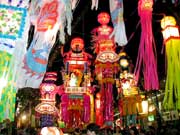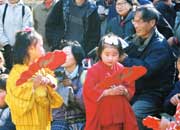The beginning of Obon is called “Bon-iri”. In many regions nationwide, they set July 1st or July 7th as Bon-iri. It is the beginning of the season of Obon which lasts for a month.
There are many events in Obon. We can know from this that the Japanese people cherished Obon very much. The variety of the contents of the events in each region shows the folksy imaginative power of the Japanese people. If we locate Bon Dancing in these events of Obon, we begin to realize various things.
*According to the date of the following events, we introduced them in lunar calendar unless it is necessary
*Please refer to the research volume as to the rituals and events of Urabon-e in the Buddhist temples.
Kamabuta-tsuitachi
They call July 1st as “Kamabuta-tsuitachi”, and there are many places in Japan which believe that Obon starts from this day (=Bon-iri).Some people may have heard that “The cover of hell opens in Obon”. The name “Kamabuta-tsuitachi” derives from the tradition that in this day the cover of hell opens. Hell could be put as “Kingdom come”. It passes down the story that it is the beginning of the season which the spirits come back from kingdom come.
“Kama-no-futa-no-iwai”,
“Kama-no-kuchi-ake”.
Nanuka Bon
There are many regions in which they set July 7th as Bon Iri. In Tohoku and Chugoku region, they call Nanuka-bi, and in Kinki region they call Nanuka-bon.
There are such events as; cleaning of the grave, Bon-dana making, polishing the Buddhist altar articles, mowing the streets; in Nanuka-Bon.
Bon events and Tanabata
July 7th is the day of “Tanabata”, as you know.
Today, many people believe that Tanabata is held on July 7th and “Obon” is around August 15, and thereby these are completely different events. However, in the lunar calendar, there is around a week from Tanabata to Obon, and they had a strong feeling that Tanabata is the “Beginning of Obon”.

Tanabata Festival of today (Hiratuka City, Kanagawa Prefecture)
Events concerning “the water”
Especially in Tohoku and Kanto region, there are many events concerning the water in Tanabata.
*”Bathe 7 times and eat festive red rice 7 times”
*Women wash their hair: nationwide
*The whole family takes a quick bath in a washtub
*Wash the cattle: nationwide
*Wash the dishes
*Clean out the well, clean out the river, pond
*”Nebuta” is also an event of Tanabata
“Nebuta” (Aomori) and “Neputa” (Hirosaki) are famous as summer festivals in Tohoku Region, but these are originally events of Tanabata. In the regions of Tohoku Region, they also call it “Nemuri-nagashi” and in the Ashikaga Region of Tochigi Prefecture, they call it “Nebuto-nagashi”. This is an event to throw the sleepiness of summer into the river by consigning it to the “Nemuno-ki (silk tree)” which the sound resembles to Nemuke (sleepiness). We can also say that this event is a kind that concerns “water”
*Events of the children
There is an aspect of “An event for children” as one of the characteristics of Tanabata.
There are many events in Tanabata that value the relations with the children, such as “Children bathe 7 times”
The interesting events of children are, “Konashikko” and “Konashikkura” which were widely seen in the Kanagawa Prefecture.
This is an event that the children of the village who are usually compatible form a line facing each other across the river and swear telling bad words in the early-evening on the 7th of Obon. The leading role is the girls under the age of majority and they exchange shocking slander. However, they returned to good friends after Obon, so this was a hard-boiled event characteristic to the girls of the Kanto Region. Unfortunately, we can’t see this today, but I hope we could see “Konashikkura” of the modern girls.
“Komachi Dancing” “Tanabata Dancing”
Komachi Dancing is a dance that was danced by the girls during Tanabata in the beginning of Edo Era. One suggestion is that it was danced by the girls who expected to make a good match sharing the good luck with the legend of Tanabata.
A Furyu Dancing that the girls danced from Tanabata to Bon. It is also called “Tanabata Dancing”, and it was performed floridly in Kyoto from Shouho to Kambun years. Girls of age 7 to 18 wearing beautiful costumes with colorful design also with brow band and sash and Japanese hairpin beat time with fringed Uchiwa Drum went singing through the streets, and visited houses and danced in circles. One of the dance songs goes, “Bon, bon, bon ends tomorrow. Tomorrow a bride will wither away.” It already declined in the years of Kyoho, and today we can see the traces of the time in “Bon bon” which is the Bon event of Matsumoto City, Nagano Prefecture. (“Kokushi Daijiten” (The encyclopedia of National History))
It is held in “Tanabata” period
The Tanabata in the lunar calendar falls on the beginning of Obon. Therefore, we can guess that “Komachi Dancing (Tanabata Dancing)” had a characteristic as a “Prelude” of the original Bon Dancing that is held around 15th.
Girls only
Of course it has to do with the character of Tanabata which is an “Event for children”, but it is not only that.
Mr. Shigeru Gorai pays attention to the relation between “Shira-byoushi (courtesans)” (which is one of the bearers of Odori Nembutu of the Middle Ages) and Komachi Dancing. (Shigeru Gorai, “Odori Nembutu” Heibon-sha).
He points out that the “Counting rhyme” which also remains in the Bon Dancing songs of today is originally a culture of Shira-byoushi=the courtesans, and the Nembutu Dancing of the female attendants (who collected offerings) which has the character of Shira-byoushi, played the leading role in “Kabuki Dancing” of the early modern times which also relates to the emergence of Bon Dancing. This indicates the process in which the culture of Shira-byoushi was brought in to the folk arts such as Bon Dancing.
Girl’s Furyu “Chakkirako” which has relations with Komachi Dancing (Miura City, Kanagawa Prefecture)

The form of dancing
Forms of dancing, such as, “Walking through the streets”,” Visit the houses”, “Dance in circles” is common to the old type of Bon Dancing which can be widely seen.
